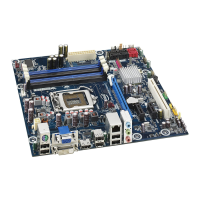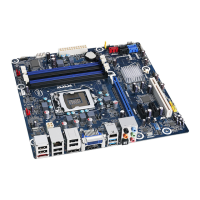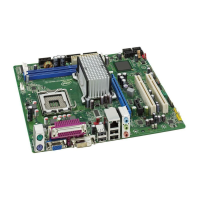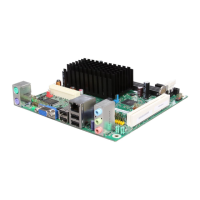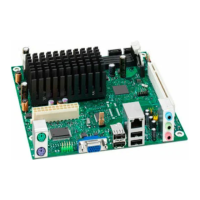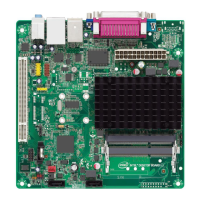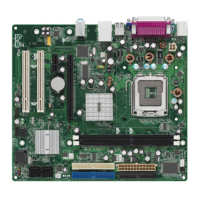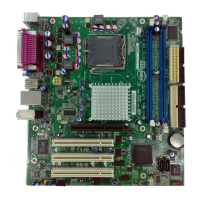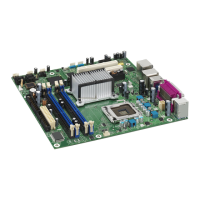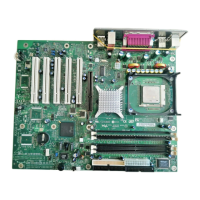
Do you have a question about the Intel W2600CR and is the answer not in the manual?
| Form Factor | SSI EEB |
|---|---|
| Chipset | Intel C602 |
| CPU Support | Intel Xeon E5-2600 series |
| Max Memory Supported | 512GB |
| USB Ports | 6 |
| LAN | Dual Gigabit Ethernet |
| SATA | 8 |
| SAS | 8 |
| Product Type | Server Motherboard |
Lists the document's chapters and their content.
Intel's disclaimer regarding server board usage and thermal requirements.
Visual layout of the Intel® Server Board S2600IP.
Visual layout of the Intel® Workstation Board W2600CR.
Compares features of S2600IP and W2600CR across various categories.
Lists component callouts and their descriptions on the main board.
Lists callouts for rear I/O components and their descriptions.
Illustrates the server board's mounting hole locations.
Details pin-1 locations for major board connectors.
Illustrates primary and secondary side keep-out zones for placement.
Provides a functional block diagram for the S2600IP server board.
Offers a functional block diagram for the W2600CR workstation board.
Details the processor socket assembly and its components.
Defines rules for populating processors in the system.
Summarizes processor initialization errors and system actions.
Lists key processor features and supported technologies.
Describes the IMC and memory subsystem functions.
Provides guidelines for UDIMM memory support.
Details support guidelines for RDIMM and LRDIMM memory.
Explains DIMM socket naming and illustrates slot layout.
Lists supported memory RAS (Reliability, Availability, Serviceability) modes.
Explains Independent, Rank Sparing, Mirrored, and Lockstep modes.
Details PCI Express* interfaces supported by the IIO.
Covers DMI2, IOAPIC, NTB, and QuickData Technology.
Covers DMI, PCI Express, and SATA controller features.
Details SAS/SATA controller and Intel® RAID C600 Upgrade Key options.
Covers PCI, LPC, SPI, DMA, Timer/Counters, Interrupt Controllers.
Details Gigabit Ethernet, RTC, GPIO, Power Management, Manageability, SMBus.
Covers NVSRAM, VT-d, JTAG, KVM/SOL, and SAS/SATA options.
Details ESRT2 and RSTe embedded software RAID options.
Lists characteristics of the server board's PCI bus segments.
Describes the onboard Intel® Ethernet Controller and its ports.
Explains the LED indicators for external RJ45 NIC ports.
Details support for adding I/O modules for networking interfaces.
Lists available I/O modules for expanding networking capabilities.
Describes support for Intel® Integrated RAID mezzanine modules.
Details HD Audio support on the Workstation Board W2600CR.
Lists standard speaker channel configurations for audio output.
Describes USB3.0 support on the Workstation Board W2600CR.
Details IEEE1394b support on the Workstation Board W2600CR.
Outlines the architecture for server management functions.
Lists the features supported by IPMI 2.0.
Details non-IPMI features supported by the BMC.
Highlights new manageability features in server platforms.
Lists basic and advanced platform management features.
Describes the integrated BMC hardware, Emulex* Pilot III.
Details the functionality of the Emulex* Pilot III BMC.
Covers Super I/O, Graphics Controller, and KVMS subsystems.
Describes the BMC's internal timestamp clock and its usage.
Details how the system clock is synchronized with the BMC.
Explains the System Event Log functionality.
Describes SDR repository and FRU inventory device functionality.
Lists common BMC beep codes for fault conditions.
Explains NMI button and BMC watchdog features.
Explains how the BMC monitors system hardware and reports health.
Lists core sensors for EPSD platforms with Xeon E5 processors.
Defines sensor types, reading types, and thresholds.
Covers BMC IP configuration and VLAN support.
Details SSH, SOL 2.0, and PEF features.
Describes BMC's support for sending LAN alerts.
Details embedded web server features and browser support.
Explains the Virtual Front Panel functionality.
Covers Embedded Platform Debug and DCMI interface.
Explains BMC firmware release numbering and boot recovery.
Details Force BMC Update and Fast Firmware Update.
Discusses how advanced management features are enabled.
Explains KVM redirection over LAN and its features.
Details media redirection capabilities and device support.
Introduces NM for power management and its architecture.
Explains SmaRT/CLST power control modes and throttling.
Describes the EU Lot 6 Mode for standby power consumption.
Details BIOS password protection, types, and strength.
Explains TPM support for boot process integrity and data protection.
Describes BIOS TPM support and physical presence verification.
Outlines TPM security setup options in BIOS.
Explains Intel® Trusted Execution Technology for a secure environment.
Details various power connectors on the server board.
Details front panel headers and connectors for system features.
Provides pin-outs for front panel USB and local control panel connectors.
Details connectors for storage devices like SATA.
Details pin-outs for multiport Mini-SAS/SATA connectors.
Details connectors for management and security features.
Details pin-outs for system fan connectors.
Provides pin-outs for Serial Port A and Serial Port B.
Details external VGA and internal video header pin-outs.
Illustrates and lists jumper blocks for system configuration.
Provides procedures for BIOS default and password reset.
Details procedures for BMC and ME firmware force updates.
Explains the procedure for using the BIOS recovery jumper.
Details the procedure for ME force update using a jumper.
Describes the location and function of onboard diagnostic LEDs.
Explains the function of stand-by, fan fault, and CPU fault LEDs.
Details the location and function of DIMM fault LEDs.
Locates system ID, status, and POST code diagnostic LEDs.
Explains how to illuminate and use the System ID LED.
Describes the bi-color System Status LED and its states.
Explains how POST codes are represented by diagnostic LEDs.
Lists the mapping of POST code diagnostic LEDs.
Defines operating and non-operating environmental limits.
Provides MTBF estimates for the server boards.
Details power supply design guidelines and voltage specifications.
Covers processor power support and TDP guidelines.
Specifies power supply output requirements for system design.
Defines power ratings and voltage regulation under cross-loading.
Describes standby output and voltage regulation limits.
Specifies requirements for dynamic loading and transient response.
Outlines capacitive loading and grounding requirements.
Details closed-loop stability, residual voltage, and common mode noise.
Covers soft starting, zero load stability, and ripple/noise.
Details timing requirements for power supply operation.
Advises on AC power removal and processor installation order.
Outlines DIMM support rules and jumper usage for CMOS/BMC/BIOS.
Explains sensor type codes and monitoring definitions.
Lists integrated BMC core sensors like Power Unit Status and IPMI Watchdog.
Lists BMC sensors related to system health and events.
Lists BMC sensors for processors, thermal margins, and VRD temperatures.
Lists BMC sensors for fans and power supplies.
Provides S2600IP platform/chassis info, IPMI channels, processor support.
Lists chassis-specific sensors, hot-plug fans, and redundancy for S2600IP.
Defines fan domains and associated components for S2600IP.
Lists HSC availability and power unit support for S2600IP chassis.
Provides W2600CR platform/chassis info, IPMI channels, processor support.
Lists W2600CR chassis sensors, fan support, and features.
Defines fan domains for W2600CR in various chassis.
Notes HSC availability and power unit support for W2600CR chassis.
Explains how POST codes are represented by diagnostic LEDs.
Provides POST progress code examples and lists.
Lists MRC progress codes displayed via diagnostic LEDs.
Lists MRC fatal errors displayed by diagnostic LEDs.
Describes DIMM population errors indicated by LEDs.
Explains POST error codes, types (Minor, Major, Fatal), and BIOS actions.
Lists supported POST error codes, messages, and their responses.
Lists POST error beep codes and their descriptions.
Lists beep codes generated by the Integrated BMC.
Contains definitions for important terms used in the document.
Lists related documents for further information.

